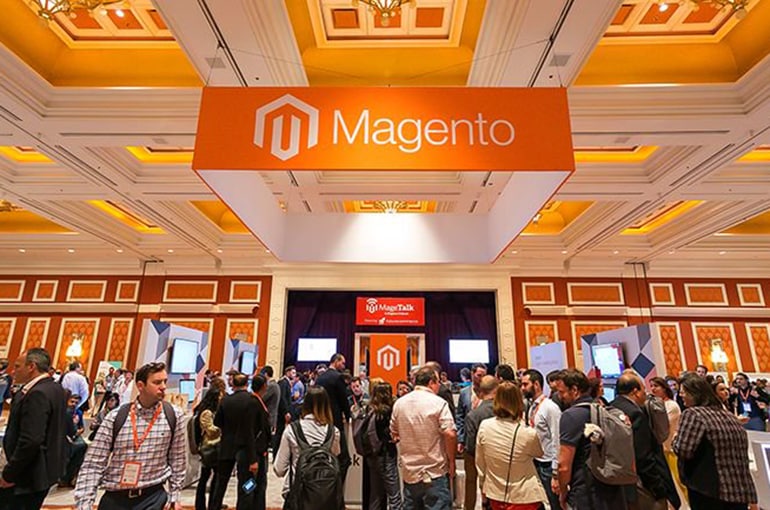5 Aspects You Need To Know About Magento E-commerce Development

Magento e-commerce development is a popular method to build purchasing online channel for your business. But to optimize the benefits of features when using, you need to know its strengths and weaknesses. The information below will help you in some way.
What Is Magento?
Magento is an e-commerce platform and CMS built on open source technology. It was created by the US private company in 2008. It meets merchants’ need through features such as flexible shopping cart system, controlling over the look, powerful marketing, search engine optimization, and catalog-management tools. Furthermore, it offers many of checkout options, supports critical global and regional payment gateways, integrates shipment tracking and advanced tax rules capabilities.
Nowadays, Magento is recognized as one of the most comprehensive online retail software and becomes popular in the e-commerce industry. Almost, there is no any e-commerce platform with the same high reputation as Magento. It makes chances for many subjects to use with a free community version and an annually paid enterprise version.
Who Is Magento E-Commerce Development For?
Up to this time, Magento has become a world’s leading solutions and has twenty-six percent of best e-commerce websites. There are hundreds of thousands of businesses using Magento to run their online store. For example, Christian Louboutin, Ford, Fox Connect, Nike, Olympus, Rebecca Minkoff, Vizio, Samsung, etc.
Benefits That You Can Obtain from Magento E-Commerce Development
1. Open Source Platform
As you knew from section I, Magento is an open-source platform, which means that:

It allows users and developers to customize, modify or extend the source code for more advanced functions or default feature optimization flexibly. Magento also has full adaptability with installing extensions that are built to meet business demands and improve customer experience instead of interfering with the source code. And it may be more developed in the future.
2. Various Features
Magento has more rich and diverse features than other e-commerce platforms such as product creation, checkout experience, promotions even marketing. These features help you manage their whole business during the process of operation and deliver great experiences as well as a satisfaction to your customers. The following are 10 Magento general features:
- Catalog management
- Site management
- Product browsing
- Search engine optimization
- Marketing, promotions and conversion tools
- Checkout and shipping
- Mobile commerce
- Customer accounts
- Order management
- Analytics and reporting
3. High Scalability
Magento supports all businesses with size from small to giant. Small businesses can start with a limited number of products and then Magento allows you to widen your business size with an unlimited number of products. You can find suitable Magento version with any business’s scale and budget. For example, Magento Go is used for small businesses and Magento Enterprise is a perfect choice for medium and large ones.
4. High Security
Security is an important matter which all store owners need to consider carefully to manage internal access and protect your store. And for Magento, security is always guaranteed at the highest level to make sure that websites are always in a state full of safety.
Magento establishes a security center to constantly provide users with every information about security, security updates as well as quick support in need. In addition, you can set up multi-level security, use a secondary password, CAPTCHA and PCI data security to prevent unexpected risks.
Because there are many integrated features so users needn’t install additional extensions. This helps Magento have fewer possibilities to be hacked in comparison with other platforms. For example, WordPress is the most attacked platform because of its many vulnerabilities.
5. SEO Friendly
Magento e-commerce development websites are popular depend on search engine optimization (SEO). Magento has SEO components enough to support users to enhance ranking on SERPs such as sitemaps (HTML and XML) URL rewrites, metadata, etc. Moreover, out-of-the-box tools make it different from other platforms and they help your website have huge inbound traffic and create more searches for your brand.
6. Multiple – Currency And Language Support
Magento widens the market and approaches the tremendous number of potential customers over the world by supporting to install many different currencies and languages for many stores. This feature help stores target wide geographical audiences that most other e-commerce platforms don’t have. That’s also why many multinational corporations acquiring Magento to operate their business.
7. High Performance
According to Aheadworks’ research about Ecommerce Platforms Comparative Speed Testing, e-commerce platforms have the fastest speed than others are Magento and Shopify.
Fast page loading speed along with effective processing time promote customers to explore content and products in the website as well as reduce page abandonment rate. The faster your website loads, the more your customers receive information. This will lead to a significant increase in your sales and profit.
Especially, Magento is an open-source platform users can optimize performance by many ways such as changing the source code to using third-parties tools, integrating your website with different payment gateways and web applications (for example, PayPal, Google Shopping, MailChimp, eBay, QuickBooks, etc).
8. Mobile-Friendly Nature
Nowadays, everyone must know the importance of the mobile phone. It not only be means of communication but also be a tool for people to handle other matter in their life and namely most people tend to purchase things through their smartphones. Therefore, in order to keep up with the latest market trend, Magento allows you to build responsive websites that are viewable on tablets, laptop, smartphones and other mobile devices without any hassle. There won’t be displaying or purchasing issues because everything in the desktop is customized and optimized with the mobile interface accordingly.
9. Numerous Extensions
Magento extensions are must-have components of a perfect website. Users can install any Magento modules to their websites to match with demand as long as bring usefulness for their own business. There are a lot of Magento extensions developed by providers and Magento partners which presented in the official store of Magento – Magento Marketplace. They help users customize and add more advanced functions to run their business better because these extensions can be applied in marketing, checkout as well as inventory or order management.
Shopify and Magento E-Commerce Development – Which Kind of E-Commerce Development Would Best Suit You?
Whether e-commerce business will be successful or not, this depends on choosing the right online store platform. There are a lot of options for businesses, but Magento and Shopify are two of the biggest current platform. They are completely different but they always compete in the race for the best e-commerce platform. They are compared in each following feature:
1. Popularity
Magento is an e-commerce platform used commonly and accounts for 14 percents of the top million websites while Shopify only accounts for 6 percents. The big businesses such as Nike, Rosetta Stone, Olympus, and Ghiradelli used Magento as well as Shopify used by Tesla and the Los Angeles Lakers’ store.
2. Coding
Magento uses PHP and it is an open-source meaning the source code is freely available and can be modified. While Shopify is proprietary and can not be. Shopify uses a coding language called Liquid and its template code can’t be altered to match specific store needs as Magento. Therefore, Shopify is the best choice for small and simple business but it is not ideal for more complex and large businesses. When you decide to choose a platform, let’s consider carefully because it determines what can be done in the future.
3. Expense
Shopify is a software-as-a-service (SAAS) and users must pay a monthly subscription fee to access the Shopify software. They will allow you to try freely but then you must pay. Shopify pricing as follows:
- Basic $29/month
- Pro $79/month
- Unlimited $179/month
The Community version of Magento is free to download, a perfect choice for startups and small businesses. The Enterprise version cost depends on the specific online store needs. Magento pricing as follows:
- Community Edition: FREE
- Hosting: $4-$100+/month
For Shopify, users must pay more money monthly to access more features like abandoned cart recovery, gift cards, and advanced reporting. But for Magento, with lower price monthly, users can get similar features.
Hosting is an important element for a successful store. It affects the speed of the website, storage, and the number of products. Shopify is hosted by the company while Magento is a self-hosted solution. Therefore, when using Magento, users must pay third-party hosting service like SiteGround and HostGator with cost about 3.95 USD. You can select the hosting solution which is suitable with your needs and budget instead of the option through Shopify.
When payments are made through external payment gateways like PayPal, Braintree, and Authorize.net, Shopify will charge with the percentage rate from 2.0% to 0.5%. But to avoid these fees, users should pay directly through Shopify’s payment gateway.
For both Magento and Shopify, when planning cost, you must consider the costs of any add-ons because the basic software will not be enough to meet your specific demand. So that the expected price will be higher than normal.
4. Scalability
About scalability, Magento is better than Shopify for large-size stores with many products and their goal is development with more flexibility. And Shopify is the best choice for smaller stores.
Magento offers over 5,000 add-on extensions (free and paid) while Shopify only has over 100 applications and add-ons. You will get more advantage when using Magento and even it is easy to use for people not being coders.
5. Branding and Design
Design is a main part of branding brings to the success of businesses. And to support for this matter, both Magento and Shopify offer many free and premium themes. They run on an array of screen sizes with the mobile-friendly feature.
However, Shopify themes are proprietary so you are only allowed to change colors and font. Customizing themes, creating advanced issues can not be performed. While Magento supplies 2 upgrade includes drag and drop visual editing which helps non-coders create beautiful websites in a short time.
6. User Experience
There are many people said that Shopify was easy to use than Magento because you can set up shop immediately after signing up for Shopify with a website-building tool to customize features in your store.
For Magento, there are ready-made extensions and it doesn’t require coding when simple solutions already existed. Magento 2 is a new version helping users handle matters that encountering with Magento 1.
7. Speed
When customers were researching a purchasing website, they would leave or flock to other websites if your website took a while to load pages and products. Therefore, Magento and Shopify also compete in this feature each other.
Before now, when Magento has not released Magento 2 yet, Shopify is a winner in the loading speed race. But because of the appearance of Magento 2, it’s not as clear which platform performs better. Magento 2 operate an average of 20 percents faster even up to 56 percents.
8. Marketplace
Magento has beat Shopify about creating a multi-vendor marketplace although both Shopify and Magento have add-ons available to perform this work. Because Magento 2 upgrade has more scalability and performance for multi-vendor stores than the old version.
Essential Basic Steps of Magento E-Commerce Development
Step 1: Choose editions
After determining Magento is suitable with your business, let’s choose Magento version according to your purpose (Enterprise Edition or Community Edition).
Step 2: Migrate an existing online store to Magento
You need to have a developer knowing either back-end or front-end to set up Magento and it is great if someone is a specialist in both.
Step 3: Choose the hosting
If your store has a lot of products and you want heavy traffic on your site, let’s choose strong servers because Magento database is a heavy resource. Nexcess and SiteGround are two good options that you should consider.
Step 4: Build store theme
You can build unique themes according to your branding strategy or purchase a ready-made theme from Themeforest and customize to save your money.
Step 5: Add functionalities by using extensions
Using Magento extensions, external modules installed onto your store to meet specific needs in your store.
Step 6: Set Up Database
After having hosting and theme, you need to set up database below:
- Store name
- Email address for notifications
- Shipping methods
- Payment methods
- Email notifications for admins & customers
- Products
- Product categories
Step 7: Entering product information
Magento classifies and lets you choose between the following product types:
- Simple product
- Virtual product
- Downloadable products
- Configurable or Complex product
- Grouped product
- Bundled product
Step 8: Optimize website speed
If cooperating with a good hosting company but your website still loads slowly, let’s use some tips below:
- Using flat catalog feature of Magento instead of linking all the other smaller tables together. It allows customers to view all products without loading separate items at once. This helps accelerate website speed and performance.
- You can use several indexing methods of Magento to create a great summary of categories while updating the database.
- Using the built-in caching feature to optimize speed performance and you should use a 2 level caching system. Although it is a bit more complex to set up but will cache all necessary elements.
Step 9: Use a Magento API
After setting up your store with all of your products, customer groups, categories, etc. Then you should integrate Magento API with an external program or code scanning device, you can create your unique list of stock items that updates whenever a purchase is made. This helps you sync your physical store inventory with Magento inventory and simplify the work of employees and managers.
Step 10: Update version
For web programming, mistakes can lead to unwanted fatal errors so that you should hire a specialist to update your Magento version and make sure not to lose data from the database.
Step 11: Seek the right developer
Let’s choose a developer is the right one for you who have successfully completed the courses about Magento!
The Magento corporation has its certificates which include 4 types of certificates following:
- Magento Developer – A general Magento certificate
- Magento Developer Plus – A Enterprise edition Magento certificate
- Magento Frontend Developer – A theme development Magento certificate
- Solution Specialist – A project management Magento certification
Conclusion
New store owners should collect much information about other e-commerce platforms apart from Magento before deciding to build your websites. Let’s choose an e-commerce platform which suits with your goal to get the highest effectiveness in process of operation.








